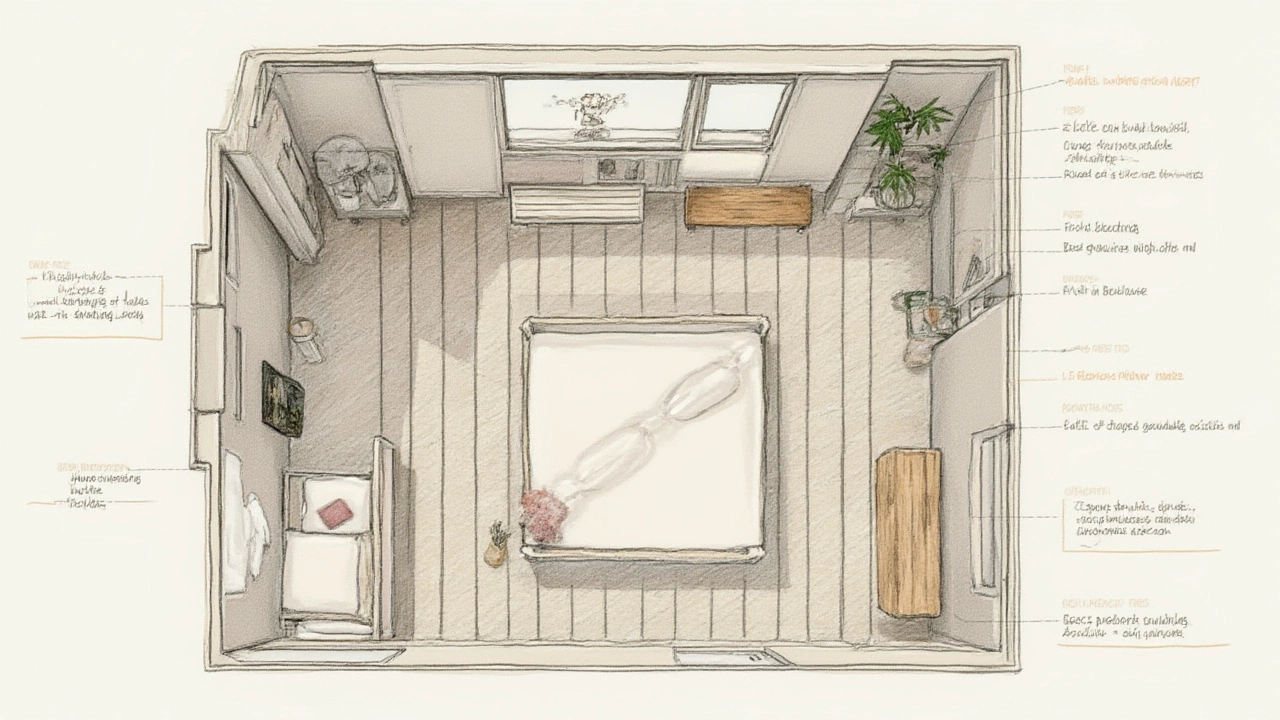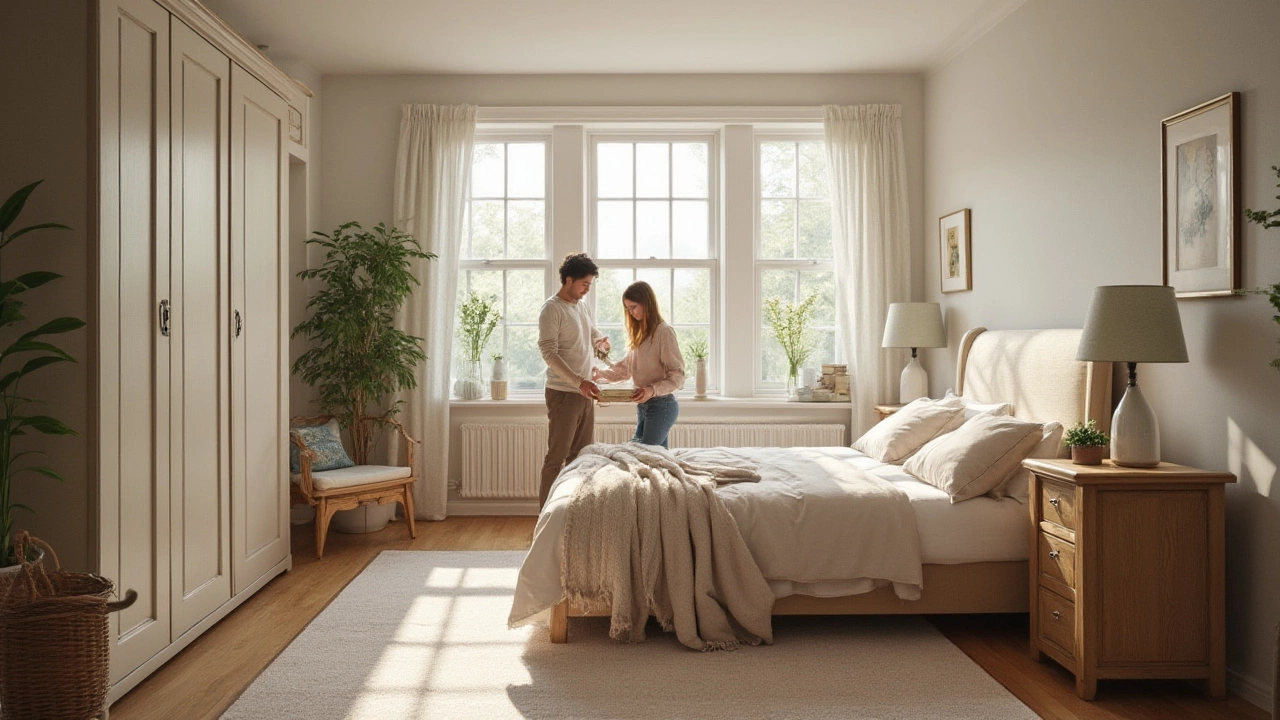There’s something almost wild about walking into an empty bedroom—something that feels a little hopeful, a little daunting. It’s your blank canvas, but the options feel endless and the pressure is real. The way you decide where to put your furniture isn’t just about keeping things tidy. It changes how you sleep, how you dress, even how you start your day. Mess this up, and you’ll be stubbing your toe every morning—or worse, fighting with your closet before your first sip of coffee.
Understanding the Flow: How Traffic Patterns Shape Your Layout
Imagine moving through your bedroom on autopilot—rushing to the bathroom, sliding into bed in the dark, or sneaking out without waking your partner. If you have kids, it’s even more important. My daughter Elara has a knack for running straight into my shins during her midnight water raids if the path isn’t clear. So, traffic flow has to come first.
Think of your bedroom as a mini-city and your furniture as buildings. The main roads are the walking paths you use most. What’s the fastest route from the door to the bed? From the bed to the bathroom or closet? Clear the big passageways first. Experts suggest leaving at least 24 inches of space where you need to walk—enough room to turn without doing awkward furniture parkour. Push the bed up against a wall or center it under a window? Both can work, but you’ll want at least two feet on either side for easy sheet changes and midnight shuffles.
If your room is tiny, you might have to get creative. Floating the bed in the middle works in some cases, but usually it creates more stubbed toes than ‘wow’ moments. For corners that just collect dust, try a reading chair or a slim bookshelf. Never shove something big right by the door. It just makes the whole room feel cramped before you’ve even stepped in. And if you have pets or kids, remember their unpredictable paths—low benches or ottomans by the bed can actually prevent accidents by ‘catching’ falling limbs or sleepy wandering feet.
Mirrors can also play a trick on your sense of space. Place a floor-length mirror opposite the window and boom—natural light bounces around, making your path clearer and your bedroom look way bigger than it is. But keep mirrors out of direct line with the bed if reflections spook you at night (I learned this one the hard way after too many nights staring at my own silhouette, wondering if it was a burglar—nope, just me). All these small choices add up. The more you respect your bedroom’s traffic flow, the less you’ll curse under your breath getting ready at sunrise sneaking back to bed after late-night fridge raids.
The Bed Takes Center Stage: Positioning for Comfort and Style
The bed isn’t just furniture—it’s the star of your bedroom drama. Most people put their bed against the longest wall, but that’s not a hard rule. Look at the shape of your room. Is there a window you want to wake up to? A wall crying out for a big headboard? If you’re lucky, you’ll have options.
Here’s something funny: real estate agents have a trick called ‘bed anchoring.’ They’ll often center the bed opposite the main door for instant eye appeal—a move that practically every design magazine runs with. Turns out, there’s science behind this. A Cornell study found that most people feel safer and sleep better when they can see the door from bed without being in direct line with it. It feeds into our old survival instincts. For smaller rooms, push the bed into a corner if you like a cocoon vibe (kids love this, by the way), but for adults, it can feel a little too dorm-like.
Don’t skimp on bedside tables. Even a tiny stool can make a difference. And try to keep both sides of the bed open, especially if you share the space—nobody likes crawling over someone else at 2am. If your room is narrow, use wall-mounted shelves for books, lamps, or glasses of water. Save the floor space for walking.
For everyone obsessed with symmetry, it’s okay to break up the look. Place a lamp on one side and a stack of books or a plant on the other. Your furniture should match your lifestyle, not just a showroom set-up. My daughter Elara, for example, insists on having her bed under the window for the sunrise views, even if it means ducking to avoid curtains. What matters most is how the room feels when you first wake up—and when you walk back in at the end of the day.
And for those with unusually shaped rooms or awkward corners, don’t ignore them. A small bench at the foot of the bed, an upholstered chair in a nook, a skinny desk by the window—these little moves turn dead space into places you’ll actually use, like a reading spot or a space to toss tomorrow’s outfit.

Making Storage Work For You: Balancing Clutter and Calm
You can spend hours obsessing over paint colors, throw pillows, and wall art, but if you’re tripping over shoes or can’t find your favorite shirt, your bedroom will never feel peaceful. Furniture that doubles as storage is a game changer. Beds with drawers, ottomans you can open, storage benches—these aren’t just for small rooms or apartments. Even big bedrooms can feel crammed without smart storage.
Start with the closet. Place your dresser near it, so you don’t end up doing a mini-marathon from wardrobe to drawers every morning. If your closet is tiny, use vertical space. Tall dressers or chests of drawers pack more per square foot. Don’t waste valuable floor space with oversized furniture if it just holds clutter you ignore for months. Wall hooks, hanging organizers, and baskets under the bed keep things neat without making the room look stuffed.
Nightstands with drawers are a must for hiding books, earplugs, or the rogue phone charger. If you need a bigger work surface, use a vintage trunk or a small console table at the foot of your bed. Storage doesn’t mean shoving everything behind closed drawers either. Stylish open shelves for plants, hats, or keepsakes can add personality. Just aim for balance—too many open shelves, and suddenly you’re living in a garage sale.
One sneaky trick—bulk up on bedding, but store out-of-season quilts and extra linens in bins under the bed or in boxes on your closet’s top shelf. Label them clearly (trust me, you’ll thank yourself when winter rolls around). And if you rarely use a piece of furniture, like a vanity table from a bygone era or a coat rack you use once a year, consider shifting it to another room or giving it away. Bedrooms fill up fast, and every square inch should add to your comfort, not distract from it.
Keepsakes, hobbies, and tech gadgets belong here too, but only in moderation. Make sure chargers can be tucked out of sight, and dedicate a drawer to those odds and ends—otherwise, the room’s vibe goes from retreat to storage closet. The best setups put what you need within easy reach, but keep the rest visually calm and clear.
Adding Personality and Flexibility: Your Bedroom, Your Rules
No algorithm or decorator can predict what makes you feel at home in your bedroom. You might be a serial rearranger (hi, that’s me), or someone who finds a layout and sticks with it for years. Either way, your space should reflect your habits, your quirks, and your ‘real’ life.
Start with what you actually do in your bedroom. Do you read there? Do yoga? Watch TV or play video games? Or is it strictly a sleep zone? Tailor the layout to fit. For readers, put a comfy chair and a lamp in a corner. If you need to work from bed sometimes (guilty), get a good, stable bedside table that can handle a laptop and a cup of coffee.
Color choices and art matter, but so do texture and shape. Mix soft rugs with smooth wood or metal furniture for balance. Use tall pieces to draw the eye up if you have low ceilings, or anchor wide rooms with chunky dressers and wide beds. Layer in throw blankets, different pillows, or unique wall art to make it feel truly yours.
Lighting is a big deal, too. Go for layers—overhead lights, bedside lamps, fairy lights, even dimmers if you can swing it. Waking up gently or winding down with soft, warm light can actually help your mood and your sleep. According to a study by the Sleep Foundation, having bedside lights with warm, low-wattage bulbs helps reinforce your natural sleep cycles—so swap those harsh, blue-toned bulbs ASAP.
Above all, don’t be afraid to swap things around until it feels just right. Sketch the room on paper, or use your phone’s camera to try out different furniture setups. If you get inspired at midnight to slide the bed across the floor—yeah, your downstairs neighbors might be annoyed, but you might just wake up feeling brand new. Your bedroom is bedroom furniture placement central, but it’s also your private world. Make it flexible. Make it personal. Make it a place you love coming home to, every single day.


Write a comment